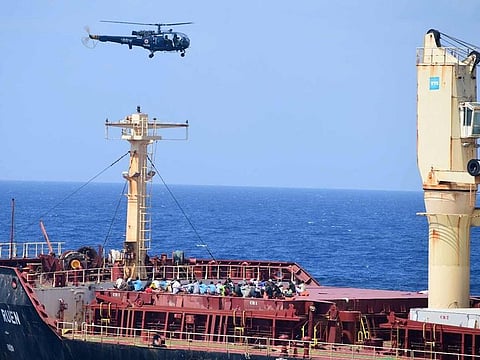India brings back 35 Somali pirates as part of operations near Red Sea
Pirates could face life imprisonment under India's 2022 anti-piracy law

New Delhi: The Indian navy handed over 35 Somali pirates to the police in Mumbai on Saturday, after 100 days of anti-piracy operations east of the Red Sea, where piracy has resurfaced for the first time in nearly a decade.
India's navy captured the pirates from the cargo ship Ruen last week, three months after it was hijacked off the Somali coast.
Taking advantage of Western forces' focus on protecting shipping from attacks in the Red Sea by Yemen's Houthi militants, pirates have made or attempted more than 20 hijackings since November, driving up insurance and security costs and adding to a crisis for global shipping companies.
With the attacks by the Houthis and the surge in piracy, commercial traffic through the region has halved since November as ships take the longer route around southern Africa, India's navy said.
The pirates seized by Indian commandoes face up to life in prison as the first to be prosecuted under India's 2022 anti-piracy law, which enables the navy to apprehend and arrest pirates on the high seas.
21 ships deployed for the operation
The Somalis were using the Ruen as their "mother ship" to launch attacks on other vessels, navy Chief Admiral R Hari Kumar told a press conference marking the 100th day of the operations.
The commandoes rescued all 17 crew members.
India has responded to 18 incidents, deploying 21 ships and 5,000 personnel in rotation, boarding and investigating over 1,000 vessels, the navy said. Its unprecedented presence has deployed more than a dozen warships some days.
"The task is to ensure that there is safety, security and stability" in the region, Kumar said.
"We are able to live up to the requirement of being a first responder and a preferred security partner... to ensure that the Indian Ocean region is safe, secure and stable." During its mission since mid-December, there have been 57 drone or missile attacks or sightings. India's navy has helped some of the attacked ships, recovering debris from drones launched by the Houthis, whom Kumar said "we really have no quarrel with".
One recovered plywood drone was capable of travelling 1,600 km (1,000 miles) with a four-stroke engine and "elementary" electronics, Kumar said.
"It doesn't require any very complicated tools to develop or manufacture these drones."
Sign up for the Daily Briefing
Get the latest news and updates straight to your inbox



